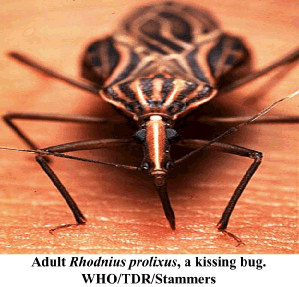
PARASITES

Malaria

Pathogens(s):
- Plasmodium falciparum protist
- Plasmodium vivax protist
- Plasmodium ovale protist
- Plasmodium malariae protist
- Plasmodium knowlesi protist
Environmental Triggers:
- Deforestation
- Defaunation
- Habitat Conversion
- Global Warming
- Urbanization, Cycles of Poverty
Epidemiology:
It is estimated that malaria causes 250 million cases of fever and approximately one million deaths annually. The vast majority of cases occur in children under 5 years old;pregnant women are also especially vulnerable. Despite efforts to reduce transmission and increase treatment, there has been little change in which areas are at risk of this disease since 1992.Indeed, if the prevalence of malaria stays on its present upwards course, the death rate could double in the next twenty years. Precise statistics are unknown because many cases occur in rural areas where people do not have access to hospitals or the means to afford health care. As a consequence, the majority of cases are undocumented.
Although co-infection with HIV and malaria does cause increased mortality, this is less of a problem than with HIV/tuberculosis co-infection, due to the two diseases usually attacking different age-ranges, with malaria being most common in the young and active tuberculosis most common in the old. Although HIV/malaria co-infection produces less severe symptoms than the interaction between HIV and TB, HIV and malaria do contribute to each other's spread. This effect comes from malaria increasing viral load and HIV infection increasing a person's susceptibility to malaria infection.
Malaria is presently endemic in a broad band around the equator, in areas of the Americas, many parts of Asia, and much of Africa; however, it is in sub-Saharan Africa where 85– 90% of malaria fatalities occur.The geographic distribution of malaria within large regions is complex, and malaria-afflicted and malaria-free areas are often found close to each other.Malaria is prevalent in tropical regions because of the significant amounts of rainfall and consistent high temperatures; warm, consistent temperatures and high humidity, along with stagnant waters in which their larvae mature, providing mosquitoes with the environment they need for continuous breeding.In drier areas, outbreaks of malaria can be predicted with reasonable accuracy by mapping rainfall. Malaria is more common in rural areas than in cities; this is in contrast to dengue fever where urban areas present the greater risk. For example, several cities in Vietnam, Laos and Cambodia are essentially malaria-free, but the disease is present in many rural regions.By contrast, in Africa malaria is present in both rural and urban areas, though the risk is lower in the larger cities. The global endemic levels of malaria have not been mapped since the 1960s. However, the Wellcome Trust, UK, has funded the Malaria Atlas Project to rectify this, providing a more contemporary and robust means with which to assess current and future malaria disease burden.
By 2010 countries with the highest death rate per 100,000 population are Cote d'Ivoire with (86.15), Angola (56.93) and Burkina Faso (50.66) - all in Africa.
Photo Source: celtnet.org.uk
Chagas Disease

Classification(s):
- American Trypanosomiasis
Pathogen(s):
- Trypanosoma cruzi flagellate protozoan
Environmental Triggers:
- Deforestation
- Urbanization
- Cycles of Poverty
Epidemiology:
Chagas disease affects eight to 10 million people living in endemic Latin American countries, with an additional 300,000–400,000 living in nonendemic countries, including Spain and the United States. An estimated 41,200 new cases occur annually in endemic countries, and 14,400 infants are born with congenital Chagas disease annually. About 20,000 deaths are attributed to it each year.
The disease is present in 18 countries on the American continents, ranging from the southern United States to northern Argentina. Chagas exists in two different ecological zones. In the Southern Cone region, the main vector lives in and around human homes. In Central America and Mexico, the main vector species lives both inside dwellings and in uninhabited areas. In both zones, Chagas occurs almost exclusively in rural areas, where triatomines breed and feed on the over 150 species from 24 families of domestic and wild mammals, as well as humans, that are the natural reservoirs of T.cruzi.Although Triatominae bugs feed on them, birds appear to be immune to infection and therefore are not considered to be a T. cruzi reservoir. Even when colonies of insects are eradicated from a house and surrounding domestic animal shelters, they can re-emerge from plants or animals that are part of the ancient, sylvatic (referring to wild animals) infection cycle. This is especially likely in zones with mixed open savannah, with clumps of trees interspersed by human habitation.
Photo Source: bc.edu
